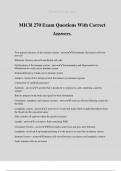©THEBRIGHT 2024
MICR 270 Exam Questions With Correct
Answers.
Two general functions of the immune system - answer✔✔Discriminate: Recognize self from
non-self
Eliminate: Destroy non-self and altered self cells
Dysfunctions of the immune system - answer✔✔Autoimmunity and Hypersensitivity:
Misdirected or overly active immune system
Immunodeficiency: Under-active immune system
Antigen - answer✔✔A foreign protein that induces an immune response
Contraction of "antibody generator"
Antibody - answer✔✔A protein that is produced in response to, and countering a specific
antigen
Bind to antigens in the body and signal for their elimination
Circulatory, lymphatic and immune systems - answer✔✔Create an efficient filtering system for
the body
Lymphatic system - answer✔✔A network of vessels that drains fluid (lymph) that filtered from
the blood into the interstitial space
(like corridors of a prison where the guards circulate)
Lymph - answer✔✔a colourless fluid containing WBC
Circulatory System - answer✔✔Where lymph comes from and goes after filtration
Lymphatic vessels pick up lymph and bring it to the heart to re-enter the circulatory system
Immune System - answer✔✔Immune cells travel between circulatory and lymphatic systems
Some immune cells are in tissues
, ©THEBRIGHT 2024
Mature immune cells travel in the blood to the infection site
Lymphoid organs and tissues - answer✔✔Organs mostly act as sites for immune cell generation,
training and/or action
Bone marrow, Lymph nodes, MALT, Spleen, Thymus
Bone Marrow - answer✔✔Structure: flexible tissues filled with hematopoietic cells
Location: central cavity inside the bones
Function:
- red marrow = site of hematopoiesis, origin of all immune cells, site of B-cell development
- yellow marrow = some leukocyte development, produces fat and cartilage
Hematopoiesis - answer✔✔Formation and differentiation of blood cells
Lymph Nodes - answer✔✔Structure: small, bean shaped, numerous, filled with lymphocytes ,
macrophages and dendritic cells
Location: grouped along lymphatic vessels
Function: filter lymph, usually first organized lymphoid structure antigens encounter
MALT (Mucosal Associated Lymphoid Tissues) - answer✔✔Structure: Combined surface area
of various areas in the body
Location: mucous membranes lining the digestive, respiratory and urogenital systems
Function: Initiates immune response to specific antigens encountered along mucosal surfaces
Spleen - answer✔✔Structure: large, ovoid, two compartments (red pulp: cords of Billroth -
fibrils and connective tissue cells with monocytes and macrophages, white pulp: filled with
macrophages, lymphocytes, T-cells, B-cells and RBC)
Location: left abdominal cavity
Function: red pulp filters blood, white pulp is the site of immune response development against
antigens in the blood
Thymus - answer✔✔Structure: Flat, Bi-lobed, filled with thymocytes (T-cells in the thymus),
epithelial cells, dendritic cells and macrophages
Location: above the heart
Function: Site of T-cell development and maturation
Primary Lymphoid Organs - answer✔✔Thymus and bone marrow
, ©THEBRIGHT 2024
- Site of lymphocyte maturation
- B-cell --> Bone marrow
- T-cell --> Thymus
Secondary Lymphoid Organs - answer✔✔Spleen, lymph nodes and MALT
-Site of lymphocyte activation through interaction with trapped antigens
Discrimination - answer✔✔Ability of immune cells to recognize self vs non-self
Cells in the body present Major Histocompatibility Complex Class I (MHC I) that is a sample of
proteins found inside the cell
MHC II are on special cells of the immune system
Immune cells scan and recognize abnormalities with the MHC and can initiate immune response
Elimination - answer✔✔Ability of immune cells to initiate an immune response
Pathogen enters the body --> immune system recognizes the antigen --> activation of effector
cells --> elimination of the pathogen
Innate Immunity - answer✔✔First line of defence
Physical, soluble and cellular barriers
Immediate recognition and response
Non specifically recognize general patterns
Adaptive Immunity - answer✔✔Humoral immunity (B-cells), cell mediated immunity (T-cells)
Longer time to initiate response, recognize and respond to specific antigens, immunological
memory
Evolution of the immune system - answer✔✔Many prominent aspects of human immune system
recognized in the immune system of less complex species
Innate immunity: found in vertebrates, invertebrates and plants
Adaptive immunity: found only in subphylum vertebrata (all animals with backbones), B and T
cells only found in jawed vertebrates
Pregnancy and Immunity - answer✔✔Immune system in state of flux with specific cell types
recruited to implantation site, after 12 weeks enters immune dampening, end of term enters
immune flux
, ©THEBRIGHT 2024
Origin of Immune Cells - answer✔✔Every immune cell originates from pluripotent
hematopoietic stem cells in fetal liver and bone marrow
Hematopoietic Stem Cell - answer✔✔Every blood cell arises from this
Self Renewal:Ability to divide itself to replace older cells and keep the pool of stem cells
constant
Pluripotent (multipotent): can differentiate into many other cell types but once a stem cell
commits to a lineage it loses self renewal ability
Lymphoid Lineage - answer✔✔lymphoid progenitor cells differentiate to make up the adaptive
immune system
Major cells are the T and B cells (lymphocytes)
lymphoid progenitor - answer✔✔Ability to differentiate into B-cells (plasmocyte = effector B-
cell, Memory B-cell), T-cells (Helper T-cell, Cytotoxic T-cell, Memory T-cell), Natural Killer
Cells
Myeloid Lineage - answer✔✔Differentiate into most cells of innate immunity
Myeloid Progenitor - answer✔✔Differentiate into Granulocyte (neutrophil, eosinophil, basophil,
mast cell), Monocyte (macrophage), Erythrocyte, Thrombocyte
Dendritic Cell - answer✔✔Arise from myeloid or lymphoid progenitor cells
Part of adaptive and innate immunity
Function to capture and engulf antigens and present them to the adaptive immune cells
Various subsets
Erythrocytes and Platelets - answer✔✔Platelets: coagulation, wound healing and fibrinolysis
Inflammatory function influencing innate and adaptive immunity
Involved in - intervention against microbes, recruitment and promotion of innate effector cell
functions, modulate antigen presentation, enhance adaptive immunity
Erythrocytes and Platelets:
formed during hematopoiesis
Monocyte and Macrophage - answer✔✔- are phagocytes
- Monocytes are in the blood
- macrophages are in the tissues




